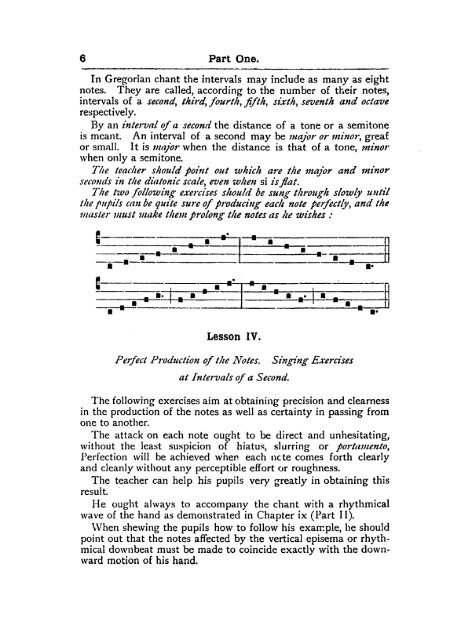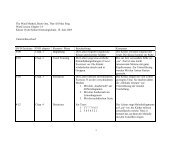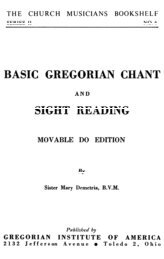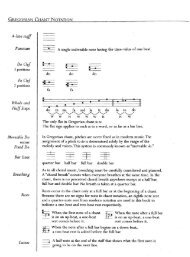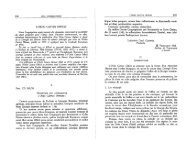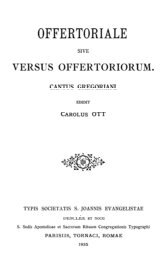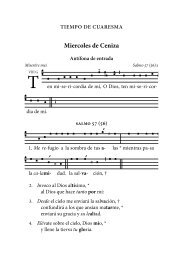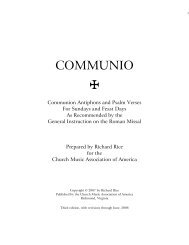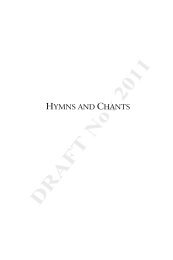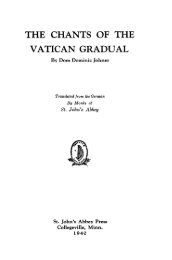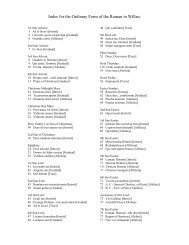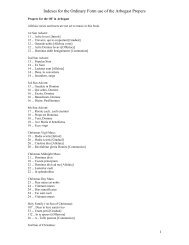- Page 1: TEXT BOOK OF GREGORIAN CHANT ACCORD
- Page 4 and 5: INTRODUCTION. Preface, introduction
- Page 6 and 7: viij. Introduction. could ever be g
- Page 8 and 9: Introduction. mystical body of Chri
- Page 10 and 11: xij. Introduction. " return to anti
- Page 12 and 13: xiv. Introduction. song ", 1 she do
- Page 14 and 15: xvj. Contents. CHAPTER III. Rhythm.
- Page 17 and 18: PART ONE. Lesson I. Definition of M
- Page 19 and 20: Lesson I. Examples of clefs on diff
- Page 21: Lesson III. In the Vatican Edition
- Page 25 and 26: Lesson V. B) NEUMS OF THREE NOTES.
- Page 27 and 28: Lesson VI. In order to sing correct
- Page 29 and 30: Lesson VII. 13 without drawling, th
- Page 31 and 32: I 1 L | 2. 4- i • i a. t. Lesson
- Page 33 and 34: a. a. a.t. tf Lesson X. Lesson X. a
- Page 35 and 36: Lesson XII. 19 The interval cf a se
- Page 37 and 38: Lesson XII. 21 N. B. In this type o
- Page 39 and 40: Lesson XII. 23 R. Care must be take
- Page 41 and 42: Lesson XIII. 25 by aspiration (mise
- Page 43 and 44: Lesson XIV. 27 Phraseological Accen
- Page 45 and 46: Lesson XIV. 29 Redempti6nem-mfsit p
- Page 47 and 48: Chapter I. — Gregorian Tonality.
- Page 49 and 50: Deuterus Tritus \ \ Tetrardus \ Cha
- Page 51 and 52: CO p u 1t . r 1 Upper Range Lower R
- Page 53 and 54: Tritus Mode V and VI Chapter I. —
- Page 55 and 56: Chapter I. — Gregorian Tonality.
- Page 57 and 58: Chapter I. — Gregorian Tonality.
- Page 59 and 60: Chapter I. — Gregorian Tonality.
- Page 61 and 62: Chapter I. — Gregorian Tonality.
- Page 63 and 64: Chapter II, — The Singing of the
- Page 65 and 66: f 1 Int. Chapter II. — The Singin
- Page 67 and 68: Chapter IT. — The Singing of the
- Page 69 and 70: Chapter II. — The Singing of the
- Page 71 and 72: Chapter II. — The Singing of the
- Page 73 and 74:
Chapter II. — The Singing of the
- Page 75 and 76:
Chapter II. — The Singing of the
- Page 77 and 78:
Chapter II. — The Singing of the
- Page 79 and 80:
Chapter II. — The Singing of the
- Page 81 and 82:
Chapter III. — Rhythm. 65 diction
- Page 83 and 84:
Chapter III. — Rhythm. 67 which a
- Page 85 and 86:
Chapter III. — Rhythm. 69 The tra
- Page 87 and 88:
Chapter III. — Rhythm. 71 Instead
- Page 89 and 90:
Chapter III. — Rhythm. 73 the mel
- Page 91 and 92:
Chapter III. — Rhythm. 75 Having
- Page 93 and 94:
Chapter III. — Rhythm. 77 nothing
- Page 95 and 96:
Chapter III. — Rhythm. 79 of the
- Page 97 and 98:
Chapter IV. — Rhythm of Words and
- Page 99 and 100:
Chapter IV. — Rhythm of Words and
- Page 101 and 102:
Chapter IV. — Rhythm of Words and
- Page 103 and 104:
Chapter IV. — Rhythm of Words and
- Page 105 and 106:
Chapter IV. — Rhythm of Words and
- Page 107 and 108:
Chapter V, — Special Execution of
- Page 109 and 110:
Chapter V. — Special Execution of
- Page 111 and 112:
Chapter VI. — The Rhythmic Suppor
- Page 113 and 114:
Chapter VI. — The Rhythmic Suppor
- Page 115 and 116:
Chapter VI. — The Rhythmic Suppor
- Page 117 and 118:
Chapter VI. — The Rhythmic Suppor
- Page 119 and 120:
Chapter VI. — The Rhythmic Suppor
- Page 121 and 122:
Chapter VI. — The Rhythmic Suppor
- Page 123 and 124:
Chapter VI- — The Rhythmic Suppor
- Page 125 and 126:
The Rhythm of Sections and Members.
- Page 127 and 128:
i Chapter Protasis a B • s '— E
- Page 129 and 130:
Chapter VIII, — The Rhythm of the
- Page 131 and 132:
Chapter VIII. — The Rhythm of the
- Page 133 and 134:
Chapter IX. — Conducting the Chan
- Page 135 and 136:
Chapter IX. — Conducting the Chan
- Page 137 and 138:
Chapter IX. — Conducting the Chan
- Page 139 and 140:
Chapter IX- — Conducting the Chan
- Page 141 and 142:
Chapter X. — Practical Examples.
- Page 143 and 144:
Chapter X. — Practical Examples.
- Page 145 and 146:
Chapter X. — Practical Examples.
- Page 147 and 148:
Chapter X. — Practical Examples.
- Page 149 and 150:
tide nobis... omy. I # X e-» V- am
- Page 151 and 152:
Chapter X. — Practical Examples.
- Page 153 and 154:
v Chapter X, — Practical Examples
- Page 155 and 156:
Chapter X. — Practical Examples.
- Page 157 and 158:
Chapter I. — Hymns. 139 tonic acc
- Page 159 and 160:
Chapter II. — The Common Tones. 1
- Page 161 and 162:
Chapter II• — The Common Tones.
- Page 163 and 164:
Chapter III. — Liturgical Recitat
- Page 165 and 166:
Chapter III- — Liturgical Recitat
- Page 167 and 168:
Chapter III. — Liturgical Recitat
- Page 169 and 170:
Chapter IYr — Accompaniment. 151
- Page 171 and 172:
Chapter IV- — Accompaniment. 153
- Page 173 and 174:
^ Chapter IV. — Accompaniment. 15
- Page 175 and 176:
Chapter IV. — Accompaniment. 157
- Page 177 and 178:
Chapter IV. — Accompaniment. 159
- Page 179 and 180:
Chapter IV. — Accompaniment. 161
- Page 181 and 182:
Historical Survey, Ecclesiastical L
- Page 183 and 184:
Historical Survey. Ecclesiastical L
- Page 185 and 186:
Historical Survey. Ecclesiastical L
- Page 187 and 188:
Historical Survey. Ecclesiastical L
- Page 189 and 190:
Historical Survey. Ecclesiastical L
- Page 191 and 192:
Historical Survey. Ecclesiastical L
- Page 193 and 194:
Historical Survey. Ecclesiastical L
- Page 195 and 196:
Ecclesiastical Legislation. 177 for
- Page 197 and 198:
Ecclesiastical Legislation. 179 REG
- Page 199 and 200:
Ecclesiastical Legislation. 181 tak
- Page 201 and 202:
Ecclesiastical Legislation. 183 lic
- Page 203 and 204:
Ecclesiastical Legislation. 185 and
- Page 205 and 206:
Ecclesiastical Legislation. 187 hea
- Page 207 and 208:
Ecclesiastical Legislation. 189 to
- Page 209 and 210:
Ecclesiastical Legislation. 191 gor
- Page 211 and 212:
Ecclesiastical Legislation. 193 II.
- Page 213 and 214:
Ecclesiastical Legislation. 195 by
- Page 215 and 216:
Ecclesiastical Legislation. 197 up
- Page 217 and 218:
Ecclesiastical Legislation. 199 ren
- Page 219 and 220:
Ecclesiastical Legislation. 201 cat
- Page 221 and 222:
Ecclesiastical Legislation. 203 Thi
- Page 223 and 224:
Ecclesiastical Legislation. 205 in
- Page 225 and 226:
Ecclesiastical Legislation. 20*3 Th
- Page 227 and 228:
Ecclesiastical Legislation. 209 We
- Page 229 and 230:
Ecclesiastical Legislation. 211 VI.
- Page 231 and 232:
Ecclesiastical Legislation. compete
- Page 233 and 234:
BIVIRGA, BLESSINGS, CADENCE, CANTIL
- Page 235 and 236:
ICTIC, IMPULSION, SECTION, INTERVAL
- Page 237 and 238:
PLAGAL, PODATUS, PORRECTUS, POSTICT
- Page 239:
TONIC, TORCULUS, TRANSPOSED MODES,


